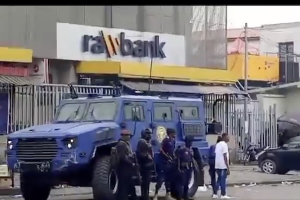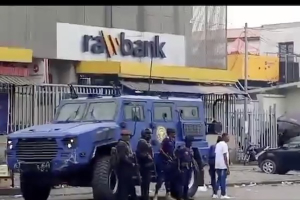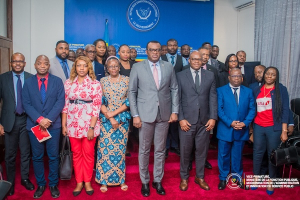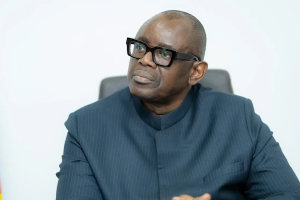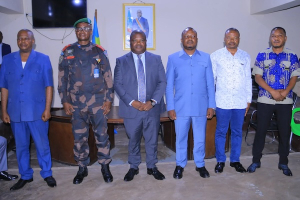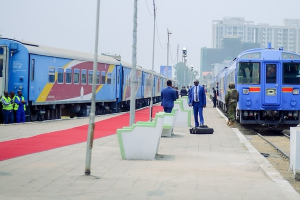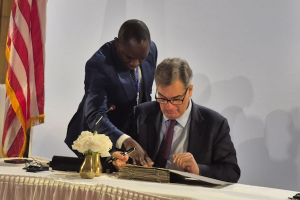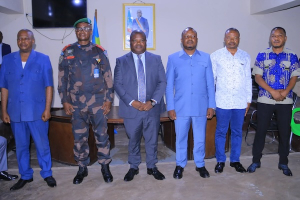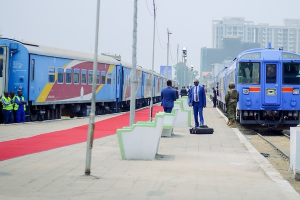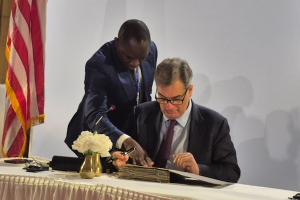Equipe Publication
Armed robbery attempt foiled at Rawbank branch in Kinshasa
A robbery attempt targeted Rawbank’s Victoire branch in Kinshasa’s Kalamu district early on October 16, 2025. According to witnesses, a group of heavily armed men stormed the premises, taking customers and staff hostage.
Security forces quickly responded, surrounding the building and engaging in an exchange of gunfire with the attackers, causing panic around the Victoire roundabout and nearby streets.
In a statement issued the same day, Rawbank confirmed the incident and said the situation was brought under control thanks to the swift and coordinated action of security services. The bank reported no injuries among employees or customers.
Authorities have maintained tight security around the area to allow police and judicial teams to conduct investigations. Rawbank praised the professionalism of law enforcement and the composure of the public during the operation.
Kalamu mayor Charlie Luboya told Radio Okapi that all hostages were safely freed. By midday, some assailants remained inside the bank while others had fled. Several suspects were arrested.
Kinshasa : un braquage déjoué à l’agence Rawbank de Victoire
Une tentative de braquage a visé, tôt dans la matinée du 16 octobre 2025, l’agence Rawbank de la place Victoire, dans la commune de Kalamu. Selon plusieurs témoins, un groupe d’hommes lourdement armés a fait irruption dans les locaux, prenant en otage clients et personnel.
Alertées, les forces de l’ordre sont rapidement intervenues et ont encerclé le bâtiment. De violents échanges de tirs ont opposé les assaillants retranchés à l’intérieur aux policiers déployés à l’extérieur, semant la panique dans le périmètre du rond-point Victoire et dans les rues environnantes.
Dans un communiqué publié le 16 octobre, Rawbank a confirmé l’incident, assurant que la situation avait été maîtrisée grâce à l’intervention rapide et coordonnée des services de sécurité. La banque a précisé qu’aucun blessé n’était à déplorer parmi ses employés et ses clients.
Le périmètre reste sous haute surveillance afin de permettre aux autorités judiciaires et policières de mener les constatations nécessaires. Rawbank a salué le professionnalisme des forces de sécurité ainsi que le sang-froid de la population durant l’opération.
Le bourgmestre de Kalamu, Charlie Luboya, cité par Radio Okapi, a indiqué que tous les otages avaient pu être libérés sains et saufs. À la mi-journée, certains assaillants étaient encore retranchés dans la banque tandis que des complices, postés à l’extérieur, avaient pris la fuite. Plusieurs suspects ont toutefois été interpellés.
Ronsard Luabeya
Paiement à date des agents publics : une manne de dizaines de millions $ pour les banques
Le gouvernement de la République démocratique du Congo (RDC) envisage la mise en place d’un contrat de trésorerie avec les banques commerciales impliquées dans la paie des fonctionnaires. Objectif : garantir le paiement des salaires à date fixe, alors que l’État fait régulièrement face à des tensions de liquidité.
Selon une communication du ministère de la Fonction publique, de la Modernisation de l’administration et de l’Innovation du service public, le ministre Jean-Pierre Lihau a réuni, le 8 octobre 2025, les responsables des banques concernées pour discuter des modalités. Le principe est simple : les banques avanceraient les salaires aux fonctionnaires, que l’État rembourserait ensuite avec un intérêt.
D’après les données de la Banque centrale du Congo (BCC), le taux d’intérêt annuel des prêts de court terme contractés par l’État avoisine 10 %. À ce niveau, le marché potentiel pour les banques pourrait atteindre 40 millions de dollars par an, la loi de finances rectificative évaluant la masse salariale de l’État à 4 milliards de dollars pour 2025.
Les discussions incluent aussi un mécanisme d’avance sur pension destiné à fluidifier les mises à la retraite. Dans ce schéma, les banques avanceraient les indemnités aux retraités, que l’État rembourserait sous forme de mensualités équivalentes aux anciennes rémunérations, là encore assorties d’intérêts. Présentée au gouvernement dès juillet 2025, cette réforme est de nouveau sur la table.
Le calendrier du ministère du Budget prévoit en principe le début des paiements le 15 de chaque mois, avec priorité aux policiers, militaires et enseignants. Mais les retards peuvent atteindre deux semaines, conséquence d’une trésorerie tendue. En septembre, le déficit s’est élevé à 83,8 milliards de francs congolais, avec des recettes de 3 317,2 milliards FC contre 3 401,2 milliards de dépenses, selon la note de conjoncture du 3 octobre.
Pour prévenir ces décalages, le gouvernement souhaite désormais s’appuyer sur les avances bancaires. Les établissements financiers ont, à l’issue de la réunion, exprimé leur disponibilité à accompagner l’État. Le dispositif, inspiré du mécanisme déjà utilisé pour le règlement des dettes envers les compagnies pétrolières liées aux subventions sur les carburants, devrait entrer en vigueur dès 2026.
Timothée Manoke
Lire aussi :
Fonction publique : la RDC veut maîtriser une masse salariale attendue à 4 milliards $ en 2025
La RDC mise sur les banques pour financer le départ à la retraite des agents publics
Mines : la RDC fixe les travaux à réaliser pour garder un titre minier
Le ministre des Mines, Louis Watum Kabamba (photo), a signé le 8 septembre 2025 un arrêté précisant les travaux considérés comme travaux de développement et de construction dans le cadre des droits miniers d’exploitation et des autorisations d’exploitation de carrières permanentes.
Jusqu’à présent, le Code et le Règlement minier imposaient aux titulaires de droits miniers et de carrières de prouver le commencement des travaux dans des délais bien définis — un an pour les permis de recherche et un à trois ans pour les autorisations d’exploitation — sans toutefois préciser la nature exacte des activités attendues.
L’arrêté vient combler cette lacune en définissant de manière concrète les travaux qui permettent de considérer un projet comme effectivement démarré. Il s’agit des activités prévues dans la planification figurant dans l’étude de faisabilité et dans l’étude d’impact environnemental et social approuvées. Le texte précise qu’afin d’attester de l’engagement des travaux, le titulaire d’un droit minier ou de carrière « a l’obligation de se conformer à la planification des travaux contenue dans l’étude de faisabilité approuvée ».
Dans son article 1er, l’arrêté englobe dans les travaux de développement et de construction les opérations d’accès au gisement, les travaux préparatoires, d’extraction, de roulage, de stockage, ainsi que la mise en place des installations de traitement. Ces activités incluent également la construction d’immeubles et d’infrastructures directement liées à l’exploitation minière. Les articles 5 et 6 précisent les types de travaux reconnus, qu’il s’agisse des infrastructures et aménagements de surface comme la découverture du gisement, la construction de bâtiments, puits, rampes, routes, campements, réseaux électriques et hydrauliques, ou encore des usines de traitement et de transformation. Sont également reconnus les travaux souterrains, incluant le fonçage des puits, l’installation des équipements miniers, l’électrification du fond, les systèmes d’aérage et d’exhaure, ainsi que les stations de concassage et de chargement. Par ailleurs, l’article 4 classe parmi les travaux préliminaires le bornage du périmètre, la sécurisation du site et l’aménagement de la voirie d’accès.
Surveillance accrue
Ce texte intervient dans un contexte de contrôle renforcé des titres inactifs. Le 20 août 2025, le Cadastre minier (CAMI) avait rendu publique une liste de 93 titres menacés d’annulation pour non-démarrage des travaux. Parmi les sociétés concernées figuraient Tenke Fungurume Mining, avec deux titres couvrant six carrés miniers à Lubudi (Lualaba), et la Cimenterie de Lukala (Cilu), pour un titre portant sur cinq carrés miniers à Songolo (Kongo Central).
Le 5 septembre 2025, le CAMI avait précisé que les titulaires concernés disposaient de 45 jours pour présenter leurs moyens de défense et prouver le démarrage effectif des travaux. Ce délai expire le 20 octobre 2025. Passé cette échéance, les sociétés qui n’auront pas démontré avoir entamé les travaux définis dans l’arrêté ministériel s’exposeront à la déchéance de leurs droits miniers. Conformément aux articles 561 à 563 du Règlement minier, la décision de déchéance est prise par le ministre des Mines — central ou provincial, selon le type de matériau exploité. Le titulaire dispose ensuite de 30 jours pour introduire un recours administratif. En l’absence de recours, la décision devient définitive et les périmètres concernés retournent dans le domaine public de l’État, sous forme de zones de recherches géologiques (ZRG).
La signature de cet arrêté s’inscrit dans un mouvement plus large de réorganisation du secteur minier. Bien avant la nomination, en août dernier, de Louis Watum Kabamba, un vaste chantier d’assainissement du fichier cadastral avait été engagé. Il a conduit à la libération de 594 titres miniers et de carrières, représentant 37 253 carrés miniers — soit 31 648 km² — remis à disposition pour de nouveaux investisseurs.
Fort de plus de trente ans d’expérience dans l’industrie minière et ancien dirigeant de plusieurs grands projets, Louis Watum entend poursuivre cette rationalisation. En prônant une gouvernance modernisée et une meilleure attractivité du secteur, il souhaite instaurer un climat d’investissement plus stable et transparent.
Timothée Manoke
Lire aussi :
Mines : Cimenkat, Golden Africa et d’autres sociétés perdent leurs titres
Mines : des titres de Tenke Fungurume, Cilu… menacés pour non-démarrage des travaux
Mines : Louis Watum, plus de 30 ans d’expérience portés avec humilité
Eastern DRC Provinces Unite to Rebuild Strategic Roads
The provinces of Maniema and North Kivu signed an agreement in Kindu on October 14, 2025, to jointly develop a strategic road corridor linking Cacayer, Beni, Walikale, Lubutu, and Kindu. The project is designed as a provincial extension of the Kivu-Kinshasa Green Corridor, a national infrastructure initiative led by the central government.
At the same ceremony, a second preliminary accord was concluded with Tshopo province to co-finance the rehabilitation of the 126-kilometer RP410 road between Kisangani and Ubundu.
According to local media, Maniema has already provided an initial $150,000 and 100 cubic meters of diesel to launch the works. Planned interventions on RP410 include clearing, demarcation, grading, compacting, drainage construction, and the building of engineering structures.
The interprovincial initiative, based on shared financing and pooled resources, aims to stimulate regional trade and open new economic corridors across eastern Congo. However, its success will depend on effective project execution and the security of the routes involved.
The Kisangani-Ubundu axis passes through sensitive areas. Authorities have recently reported arrests of suspected AFC/M23 members along this route, which links Tshopo, Maniema, and North Kivu via Lubutu. Clashes between AFC/M23 rebels and government forces have also been reported in Walikale, highlighting the fragile security environment surrounding these infrastructure projects.
Boaz Kabeya
ONATRA Sets Official Fares for Kinshasa-Matadi Express Train
A month after the reopening of the Kinshasa-Matadi railway line, the National Office for Transport (ONATRA) has released the official passenger fares for the new express train, seen as a key step in the revival of rail travel between Kinshasa and Kongo Central province.
According to a press release issued on October 14, 2025, by ONATRA Director General Martin Lukusa Cibangu Panu, first-class tickets are priced at $25, while luxury class seats cost $50. Payments must be made in Congolese francs at the prevailing exchange rate and at least 48 hours before departure to allow for better scheduling and traffic management, the company said.
The new fares represent a slight increase from those that circulated online in mid-September following the line’s reopening. Earlier, tickets were reportedly priced at $46 for VIP, $23 for first class, and $6 for second class. The official pricing eliminates the second class and raises rates for upper categories, a move already drawing public criticism.
For comparison, a Transco bus covering the same 366-kilometer route costs about $20 per passenger.
Beyond passenger services, the reactivation of the Kinshasa-Matadi line is expected to ease the movement of more than 4 million tons of goods that pass annually through the Port of Matadi. The renewed service should help decongest National Highway No. 1 and boost trade between the capital and the Atlantic coast.
Ronsard Luabeya
U.S.'s Hydro-Link Finalizes Deal for $1.5B Angola-Congo Power Line
The Democratic Republic of Congo (DRC) has signed a Memorandum of Understanding (MoU) with U.S.-based Hydro-Link LLC to build a 1,150-kilometer transmission line that will import 1.2 gigawatts (GW) of electricity from Angola.
The deal, worth an estimated $1.5 billion, was signed on October 14, 2025, during the DRC-U.S. Economic Forum in Washington by DRC Minister of Hydraulic Resources and Electricity Aimé Molendo Sakombi and Hydro-Link CEO Paul Hinks.
This agreement completes a series of preliminary MoUs required to advance the project. Hydro-Link first signed an initial framework with its partner Mitrelli at the 17th U.S.-Africa Business Summit held by the Corporate Council on Africa in Luanda on June 22, followed by accords with Angola and the DRC.
The transmission line is slated for commissioning in 2029, though several steps remain before construction begins, including licensing and financing. Hydro-Link plans to seek a loan from the U.S. Development Finance Corporation (DFC) to fund about 70% of the cost, with additional support from the U.S. Trade and Development Agency (USTDA) for feasibility studies and U.S. Exim Bank export credits.
In the DRC, the energy shortfall for mining operators is estimated at 1,500 MW, according to the Ministry of Mines. The new line will carry electricity generated mainly at Angola’s Lauca hydropower plant to the Kolwezi mining zone in Haut-Katanga, where major producers such as Glencore and Ivanhoe Mines operate.
The African Development Bank (AfDB) estimates that Angola currently has 1.5 GW of surplus clean hydropower capacity, projected to reach 3.5 GW by 2027. The Hydro-Link initiative is the third project aimed at transmitting this excess power to Congo’s mining centers, alongside efforts by Morocco’s Somagec and a consortium led by Trafigura and ProMarks.
“With the rapid growth of the mining sector, we anticipate a complete transformation of Congo’s energy supply over the next decade,” said Paul Hinks, CEO of Hydro-Link and founder of New York-based Symbion Power.
Kinshasa and Washington are also exploring a “minerals-for-security” partnership intended to encourage U.S. investment in the DRC. Following the MoU signing, Minister Sakombi said, “I welcome this partnership and invite American investors to follow suit.”
Ronsard Luabeya
Est de la RDC : des provinces veulent unir leurs efforts pour réhabiliter des routes
Le 14 octobre 2025 à Kindu, les provinces du Maniema et du Nord-Kivu ont officialisé, à travers un protocole d’accord, leur volonté de mutualiser leurs efforts pour créer un corridor routier reliant Cacayer, Beni, Walikale, Lubutu et Kindu. Cet axe est présenté comme une déclinaison provinciale de la politique nationale du Couloir vert Kivu–Kinshasa impulsée par l’État central.
Dans la même cérémonie, un second accord préliminaire a été signé, incluant cette fois la province de la Tshopo, afin de cofinancer la réhabilitation de la route RP410. Longue de 126 km, cette route relie Kisangani à Ubundu.
Selon les médias locaux, la province du Maniema dispose déjà d’une contribution initiale de 150 000 dollars américains et de 100 mètres cubes de gazole pour lancer les travaux. Les interventions prévues sur la RP410 concernent notamment le décapage, le traçage, le profilage, le compactage, l’aménagement de fossés latéraux ainsi que la construction d’ouvrages d’art.
Cette démarche interprovinciale, qui repose sur la mutualisation des moyens, vise à stimuler le commerce régional. Mais sa réussite dépendra de la mise en œuvre effective des travaux et de la sécurisation des axes.
La route Kisangani–Ubundu traverse en effet des zones sensibles : des arrestations de présumés membres de l’AFC/M23 ont été signalées sur cet axe reliant la Tshopo, le Maniema et le Nord-Kivu via Lubutu. Par ailleurs, des affrontements récents entre les rebelles de l’AFC/M23 et les forces loyalistes ont été rapportés à Walikale, soulignant le contexte sécuritaire fragile qui entoure ces projets d’infrastructures.
Boaz Kabeya
Train express Kinshasa–Matadi : 25 $ en première, 50 $ en luxe, la seconde classe supprimée
Un mois après la réouverture officielle de la ligne ferroviaire Kinshasa–Matadi, l’Office national des transports (ONATRA) a communiqué les tarifs applicables aux passagers du train express, présenté comme le symbole de la relance du transport ferroviaire entre la capitale et le Kongo Central.
Selon un communiqué signé, le 14 octobre 2025, par son directeur général, Martin Lukusa Cibangu Panu, le prix du billet en première classe est fixé à 25 dollars américains par passager, tandis que la classe de luxe coûte 50 dollars américains. Ces montants, payables en francs congolais, seront calculés au taux de change en vigueur au moment du règlement. L’ONATRA précise par ailleurs que le paiement doit intervenir au moins 48 heures avant le départ, afin de mieux planifier et gérer le trafic voyageurs.
Ces tarifs marquent une légère hausse par rapport à ceux qui avaient circulé mi-septembre sur les réseaux sociaux et dans certains journaux en ligne, après la réouverture de la ligne. À l’époque, ils étaient de 46 dollars pour la classe VIP, 23 dollars pour la première classe et 6 dollars pour la seconde classe. Dans la grille officielle publiée hier, la seconde classe disparaît et les prix des catégories supérieures augmentent, une évolution qui suscite déjà des critiques. À titre de comparaison, le même trajet revient à environ 20 dollars en bus Transco.
Au-delà du transport de passagers, la relance de la ligne Kinshasa–Matadi est censée faciliter l’évacuation des plus de 4 millions de tonnes de marchandises transitant chaque année par le port de Matadi, désengorger la Nationale n°1 et fluidifier les échanges commerciaux entre Kinshasa et le littoral atlantique.
Ronsard Luabeya
Lire aussi :
Corridor ferroviaire : Kinshasa–Matadi redémarre, l’extension vers Banana en vue
Reprise du trafic ferroviaire entre Matadi et Kinshasa: l'Onatra courtise les opérateurs économique
Ligne électrique Angola–RDC : l’Américain Hydro-Link boucle les accords préliminaires
En marge du Forum économique RDC–USA tenu à Washington, la République démocratique du Congo a signé, le 14 octobre 2025, un protocole d’accord avec la société américaine Hydro-Link LLC pour la construction d’une ligne de transmission de 1 150 kilomètres, destinée à importer 1,2 gigawatt (GW) d’électricité depuis l’Angola. Le document a été paraphé par le ministre congolais des Ressources hydrauliques et de l’Électricité, Aimé Molendo Sakombi, et le directeur général de Hydro-Link, Paul Hinks.
Avec cette signature, l’entreprise américaine boucle la série d’accords préliminaires (MoU) nécessaires à la réalisation de ce projet, évalué à 1,5 milliard de dollars. Lors du 17ᵉ Sommet des affaires États-Unis–Afrique du Corporate Council on Africa, tenu à Luanda le 22 juin, Hydro-Link avait signé un premier MoU avec son partenaire Mitrelli. Deux autres accords ont suivi : l’un avec l’Angola, l’autre avec la RDC.
La mise en service de la ligne est prévue pour 2029, mais plusieurs étapes restent à franchir avant le lancement effectif des travaux. Il faudra notamment obtenir les licences requises et mobiliser les financements. Hydro-Link prévoit de solliciter un prêt auprès de la US Development Finance Corporation (DFC) couvrant environ 70 % du coût du projet, complété par une assistance technique de la US Trade and Development Agency (USTDA) pour les études de faisabilité, ainsi que par des crédits à l’exportation de la US Export-Import Bank.
En RDC, le déficit énergétique des opérateurs miniers est estimé à au moins 1 500 MW, selon le ministère des Mines. Cette ligne électrique permettra d’acheminer l’énergie produite principalement par la centrale hydroélectrique de Lauca en Angola jusqu’à la frontière congolaise, afin d’alimenter la zone minière de Kolwezi (Haut-Katanga), où opèrent plusieurs grands acteurs tels que Glencore et Ivanhoe Mines.
Selon la Banque africaine de développement (BAD), l’Angola dispose actuellement de 1,5 GW d’énergie hydroélectrique propre inutilisée, une capacité qui devrait atteindre 3,5 GW d’ici 2027. Le projet de Hydro-Link est le troisième projet en cours de maturation visant à acheminer ce surplus d’électricité vers les zones minières de la RDC. Les autres projets sont portés par le groupe marocain Somagec et par un consortium formé de Trafigura et ProMarks.
« Avec la croissance rapide du secteur minier, nous anticipons une transformation complète de l’approvisionnement énergétique du Congo au cours de la prochaine décennie », a déclaré Paul Hinks, PDG de Hydro-Link et fondateur de Symbion Power, société basée à New York.
Kinshasa et Washington discutent par ailleurs d’un partenariat bilatéral baptisé « minerais contre sécurité », visant à stimuler les investissements américains en RDC. « Je me réjouis de ce partenariat et j’invite les investisseurs américains à lui emboîter le pas », a déclaré Aimé Sakombi Molendo après la signature du protocole d’accord.
Ronsard Luabeya
Lire aussi :
Ligne électrique Angola–RDC : l’Américain Hydro-Link porte un projet à 1,5 milliard $
Kamoa-Kakula : le projet Somagec, une alternative pour importer l’électricité d’Angola
Électricité : les premières exportations de l’Angola vers la RDC espérées d’ici 2030
Interconnexion électrique avec Kinshasa : Brazzaville lance ses études de faisabilité





